
Workshop at the Garden To Table Silicon Valley
Last Saturday I held a workshop for volunteers at the Garden to Table Silicon Valley Farm. It was a great experience for me and so
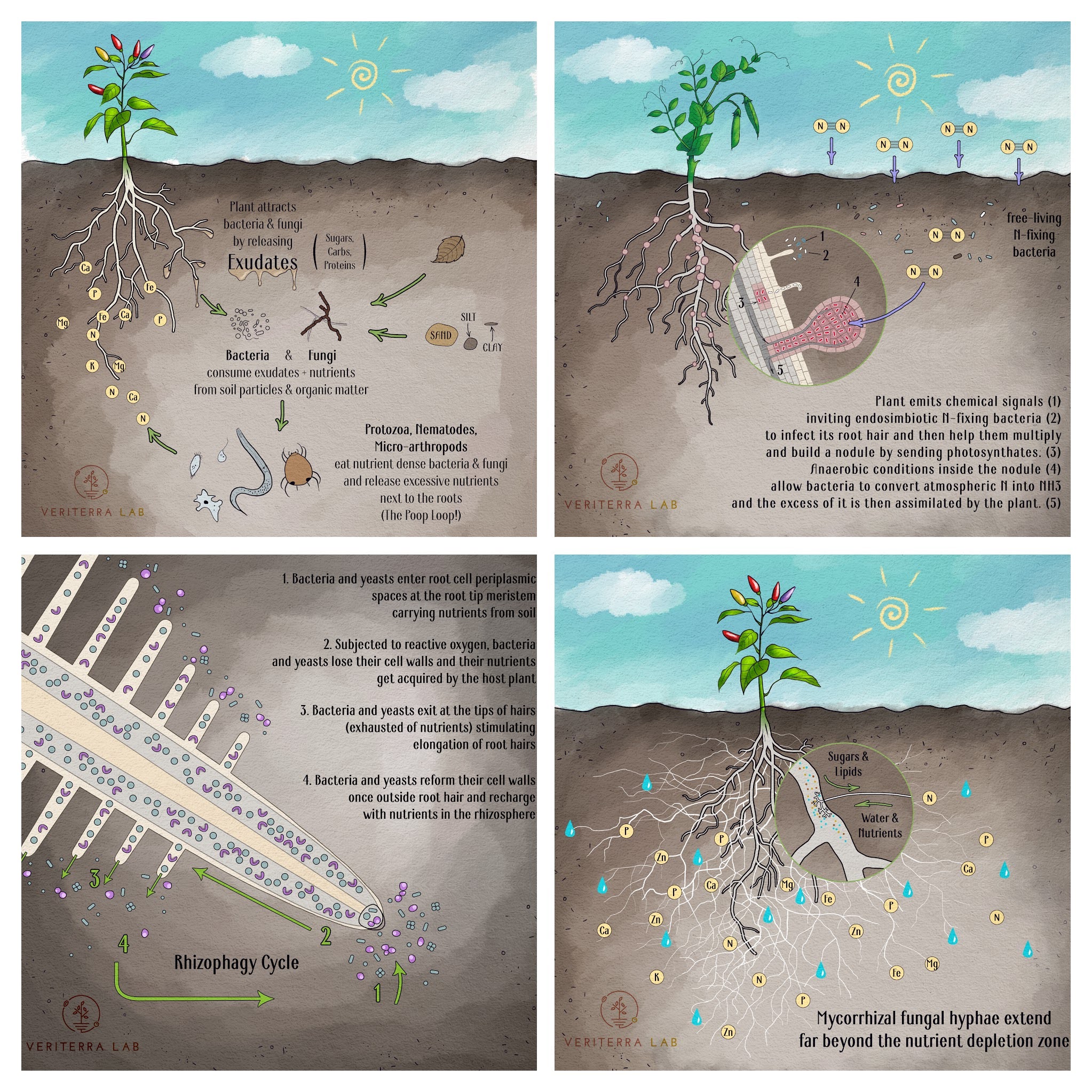
It is more accurate to say that plants and soil microbes have developed mutually beneficial ways to exchange nutrients with each other.
There are 4 mechanisms of nutrient exchange between plants and soil microorganisms that have been discovered by science so far:
I would also add to this list indirect positive effects of beneficial microbes on plants’ ability to absorb and produce nutrients. For example, the healthy soil food web create well-structured soil allowing plant roots to grow deeper into the soil and therefore capture more nutrients and water. Soil microbes also help plants photosynthesize better by providing all the necessary minerals required for the photosynthesis through the mechanisms listed above (while man-made fertilizers usually contain limited number of different nutrients).
Briefly, when a plant needs certain nutrients, it exudes a certain portion and combination of sugars into the soil around the roots – this encourages growth of certain microbes and, as a result, the plant gets desired soluble nutrients which were produced through trophic interactions of microbes in the rhizospere.
Let’s go into more details. First, the plant releases so called exudates from the roots* – mostly sugars, but also a little bit of amino acids, proteins, carbohydrates and some other compounds. The exudates attract bacteria & fungi to the root zone and they start multiplying on this easy energy source while extracting other nutrients from the soil (using their strong enzymes). These particular microorganisms are saprophytes and they don’t share nutrients with plants – something else has to happen so that plants can get nutrients they are after. Well, the large amount of bacteria and fungi attracts their predators (protozoa, nematodes, micro-arthropods) to the root zone and they start eating them. Since the concentrations of nutrients in bacteria & fungi are much higher than predators can tolerate, they excrete waste in the form of plant-available nutrients (The Poop Loop!). Needless to say that these processes are happening right in the root zone and plants can easily absorb the nutrients.
*Exudates are released from the above ground parts of plants as well, but some of them are different from root exudates and some are the same.
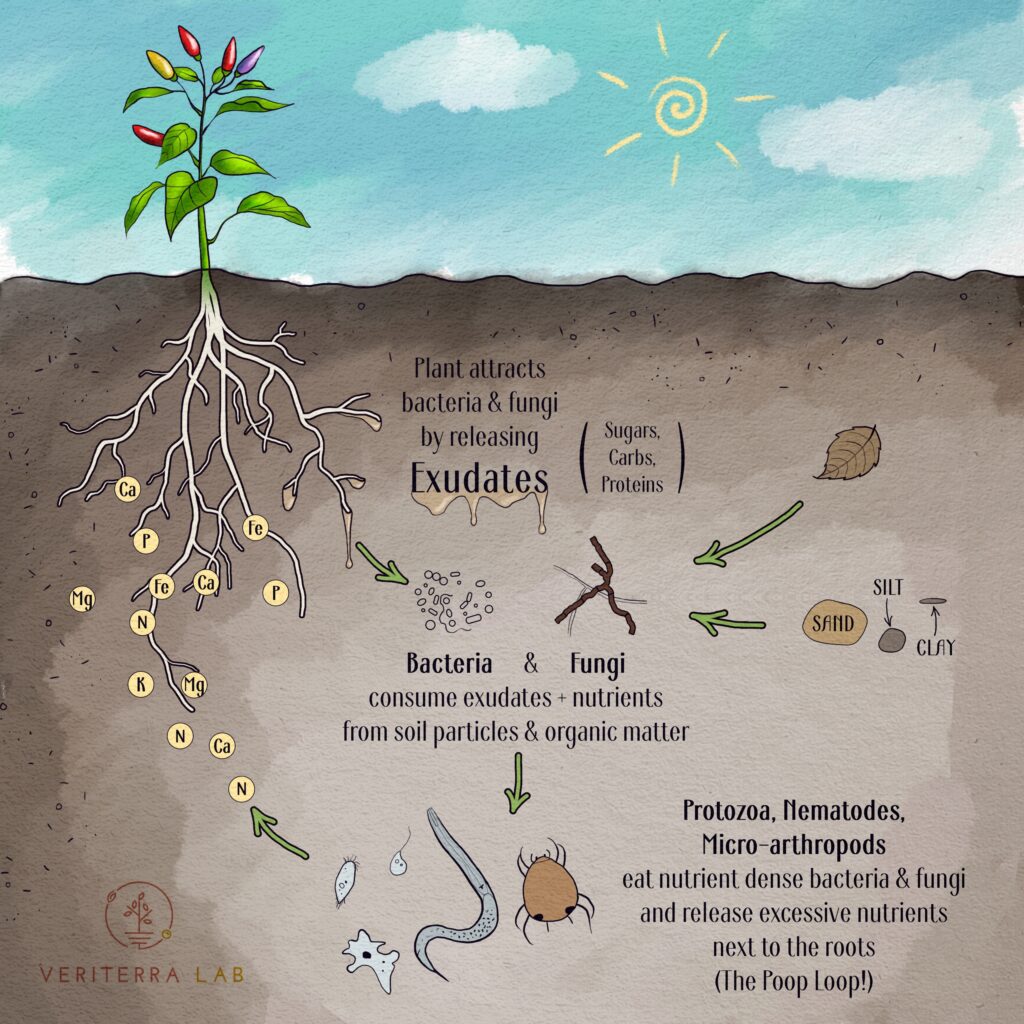
What’s fascinating is that in order to get a specific nutrient or combination of nutrients plants can release specific exudates to attract specific bacteria and fungi that are capable to obtain these exact nutrients. Knowing that, restoring the soil food web makes much more sense than trying to guess what nutrients your plants need. Fore more details read our post on comparison of nutrient cycling with fertilizers.
Mycorrhiza (“myco” – fungus, “rhiza” – root) is a mutually beneficial relationship that forms between a fungus and a plant with the purpose of exchanging resources.
It starts with a plant releasing specific exudates to wake up a mycorrhizal spore it needs. The fungal spore germinates and starts growing a hypha towards the root system by following the trail of the exudates. If the hypha reaches the root before it dies (in less than 48-72 hrs) it enters the root. The plant changes its root cellular structure to accept its fungal partner and the fungus creates a site of nutrient exchange. The type of the exchange site formed depends on the type of the fungus. For example, it can be an arbuscule of an Arbuscular Mycorrhizal (AM) fungus (illustrated below) or a hatrig net of an Ectomycorrhizal fungus. Through the exchange site the plant provides carbon (sugars & lipids) to the mycorrhizal fungus. It also “tells” the fungus what nutrients it needs through sugars and chemical signals. In return, the fungus grow a network of mycelium that extends into the soil. This mycelium absorbs nutrients from the surrounding soil and brings them back to the host plant therefore enhancing plant growth. In general, mycorrhizal fungi are very good at finding scarce nutrients or nutrients that have been depleted in the root zone!
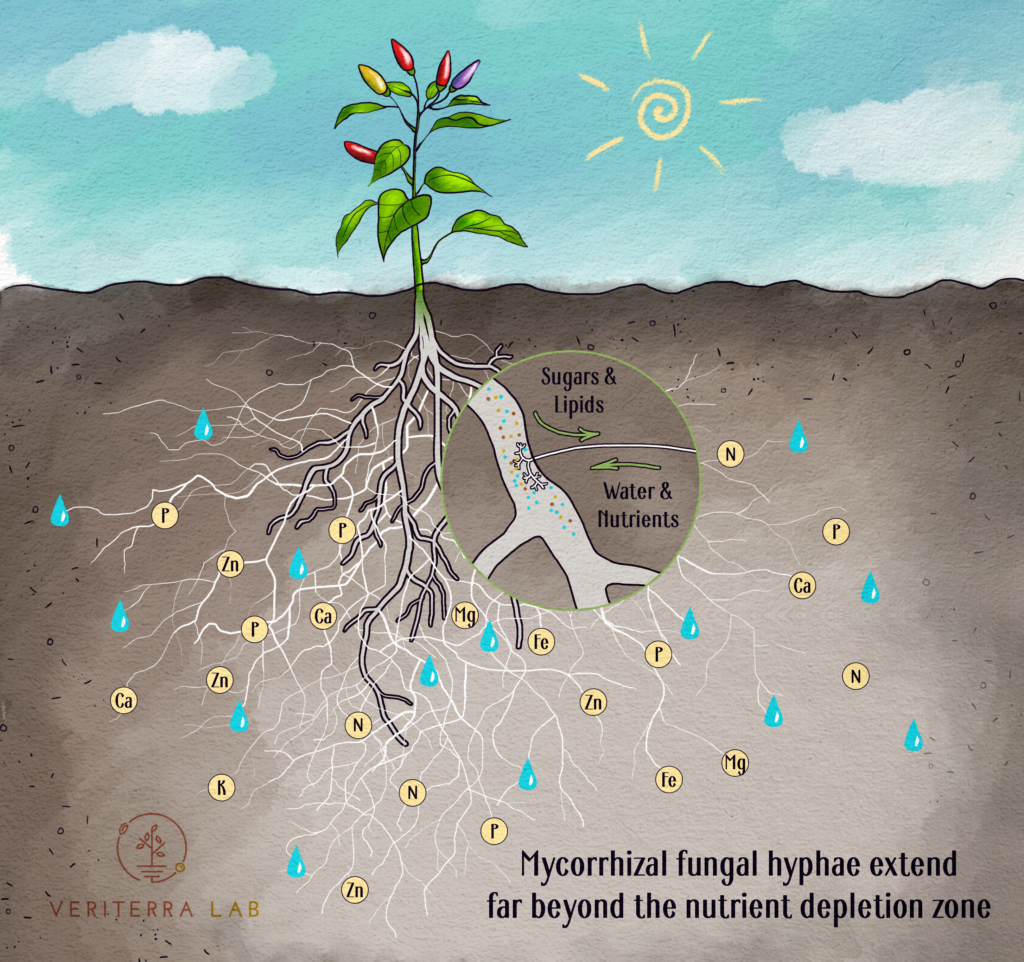
There are thousands of species of mycorrhizal fungi divided into several types. The most ubiquitous types are Endomycorrhizal (includes AM fungi) and Ectomycorrhizal fungi. Endomycorrhizal fungi colonize the majority of agricultural plant species, including fruit trees, and help their host plants access phosphorus (P), zinc (Zn), and other minerals, rarely nitrogen (N). Ectomycorrhizal fungi primarily colonize root systems of trees (conifers, oaks, hardwoods) and help their host plants access additional nitrogen that they pull from forest organic matter. Ectomycorrhizal fungi reproduce from mushrooms, while endomycorrhizal fungi reproduce from spores.
Mycorrhizal fungi can also improve plant drought and disease resistance. To learn more you may start with this easy to read comprehensive blog post about mycorrhizal fungi written by Dr. Adam B. Cobb.
Atmospheric nitrogen (di-nitrogen N2) cannot be utilized for growth by plants or microorganisms directly because of its stability. Biological nitrogen fixation is a process of converting atmospheric nitrogen into a bio-available form (ammonia NH3+) by symbiotic or free-living nitrogen-fixing bacteria.
Excess of bio-available N produced by symbiotic bacteria gets almost immediately assimilated by plants because the whole process takes place inside plant root nodules. A plant provides a niche and sugar for bacteria that can fix nitrogen and then converts rapidly excess NH3+ into NH4+ and then into amino acids. Here are a few examples of symbiotic relationships between nitrogen-fixing bacteria and plants:
Nitrogen fixed by free-living (non-symbiotic) bacteria is not so quickly available to plants. Several species of non-symbiotic nitrogen fixing bacteria have been shown to fix nitrogen and make a small contribution to the nitrogen nutrition of the plant when growing in the root zone (and consuming exudates leaking from the roots). Nitrogen fixed by free-living bacteria outside the rhizosphere of a plant remains in soil in the form of bacterial colony, but then an earthworm can come and eat that colony, or protozoa, and some of the nitrogen might be cycled to the plant eventually. Examples of free-living nitrogen fixers: Azotobacter, Beijerinckia, Cyanobacteria (some), Klebsiella (some), Clostridium (some).
Different stages of the process and transformations of a root hair are shown in the illustration below:
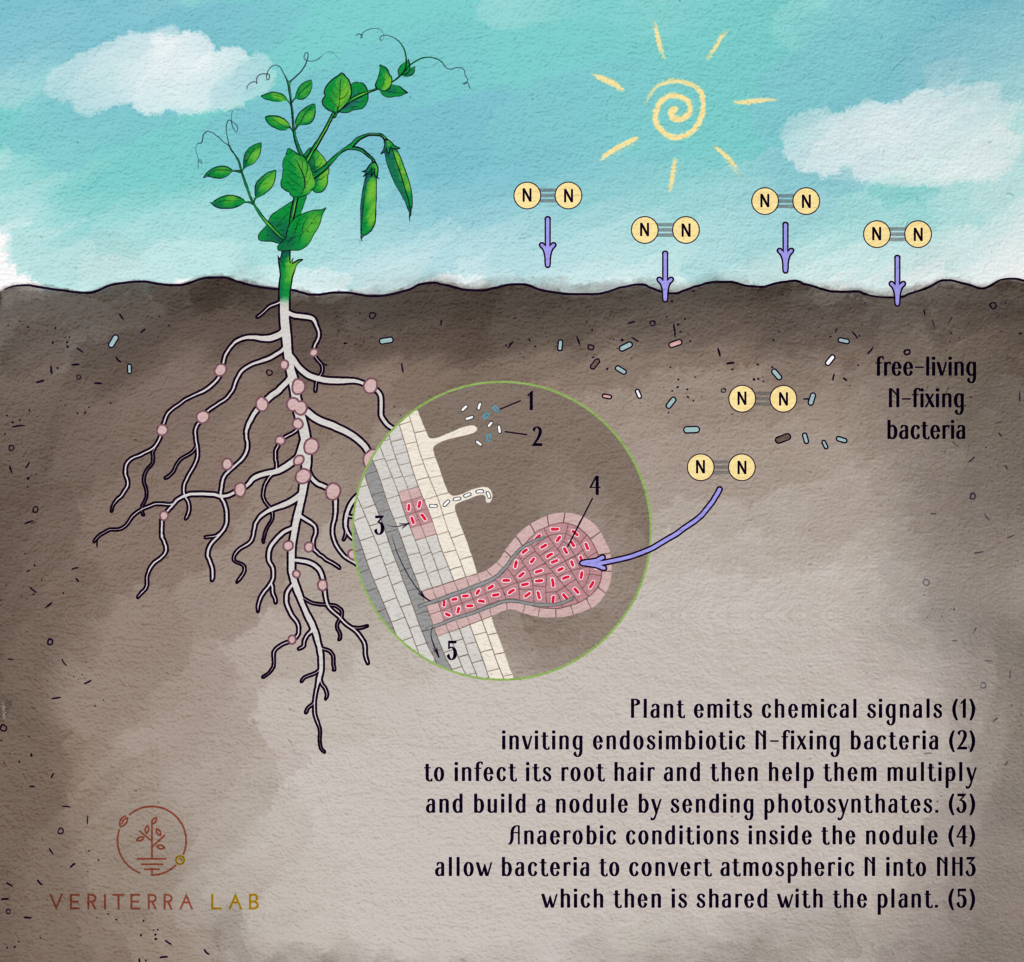
Free-living nitrogen-fixing bacteria also use nitrogenase to reduce di-nitrogen to ammonia. Some of them anaerobes and some are aerobes (e.g. cyanobacteria, Azotobacter, Beijerinckia). Obviously, the oxygen sensitivity of nitrogenase is not a problem for anaerobes. Aerobic free-living nitrogen fixers developed different mechanisms for protecting nitrogenase.
Rhizophagy cycle is a recently discovered oxidative process in plants for nutrient extraction from symbiotic microbes. It was named this way (“root eating”) because during the process nutrients that microbes obtained from soil are extracted from them in the cells of plant roots, like plant roots literally eat microbes!
As usual, a plant releases exudates from the roots to attract and grow soil microbes in the rhizospere. But in addition to waiting for nutrients that occur as a result of predator-prey interactions (The Poop Loop), the plant also absorbs some living microbes (bacteria and yeast-type fungi) that grow around the growing root tips (meristems). Inside the root (between cell walls and plasma membranes of root cells) microbes are exposed to reactive oxygen or superoxide produced by the host plant. As a result, microorganisms loose their cell walls and leak nutrients that are then absorbed into the root cells. It seems kind of harsh on microbes, but they also benefit from the rhizophagy cycle – they get a boost in population because the plant cause them to multiply. Wall-less microbes (protoplasts) replicate very quickly and when there are enough of them, they are released from the root hairs which triggers the root hairs to elongate. Once microbes get out of the root into the exudate zone, they are able to regrow their cell walls and acquire needed nutrients. Eventually they start following trail of exudates back to the tip of the root and the process begins again!
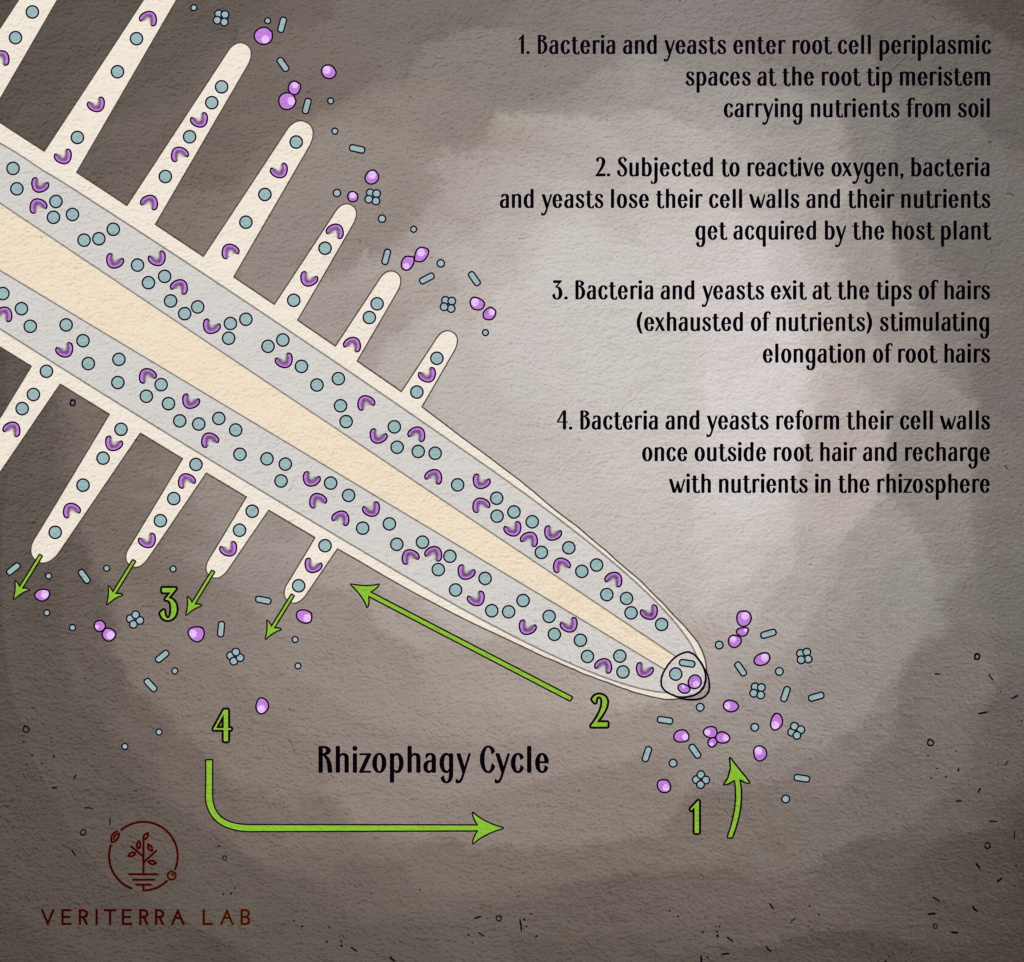
As we have seen, plants can obtain all kinds of nutrients they need by teaming with different kinds of soil microorganisms. In order for these interactions to occur 1) beneficial microbes should be present in soil 2) conditions in soil should be appropriate for microbes to thrive – no disturbance, no toxic chemicals etc. 3) plants should not be discouraged from interactions with microbes by applications of fertilizers. So if we restore beneficial microorganisms in degraded soils by using properly made compost and follow regenerative agriculture practices, we can enjoy the fruit of their labor and transition away from using expensive fertilizers!

Last Saturday I held a workshop for volunteers at the Garden to Table Silicon Valley Farm. It was a great experience for me and so
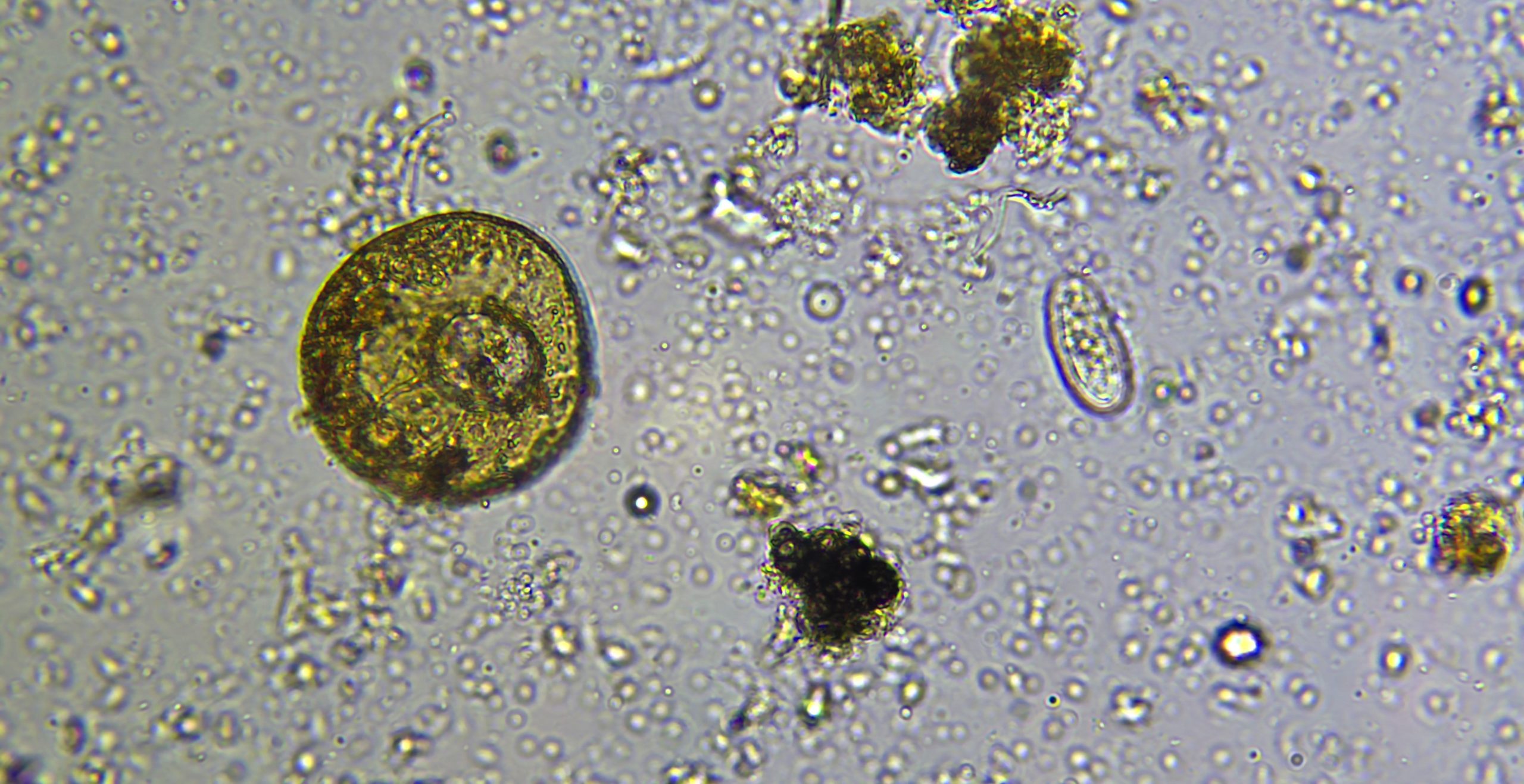
You probably heard that plant roots can take up inorganic soluble nutrients (e.g. nitrates, phosphates) directly from soil by diffusion. Sounds awesome, but it’s only
Copyright © 2025 Veriterra Lab. All rights reserved
2 Responses
Beautiful illustrations and explanations. Very impressive
Thank you, Mikaela!